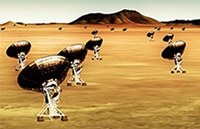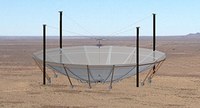Science
Futures III will continue discussions and analysis of two key opportunities emerging from the Futures I and II meetings – ngVLA and Spectral-Line Cosomology & Low Frequency Instruments, including Hydrogen Epoch of Reionization Array (HERA) and related intensity mapping opportunities. An update on other key areas – Cosmic Microwave Background (CMB), Pulsars and Midscale developments – is also planned. Over the past two years, the Kavli meeting series has coordinated a community-wide effort to explore our scientific visions for the next decade, seeking to develop consensus and support for Radio-Millimeter-Submillimeter (RMS) initiatives on all resource scales in the upcoming decadal survey.
Next Generation Very Large Array (ngVLA)
 Inspired by dramatic discoveriesfrom the Jansky Very Large Array (VLA) and the Atacama Large Millimeter/submillimeter Array (ALMA), the community has initiated discussion of a future large area radio array optimized for imaging of thermal emission to milli-arcsecond scales that will open new discovery space from proto-planetary disks to distant galaxies. This next generation Very Large Array (ngVLA) is currently envisioned to include: (a) ~10x/30x the effective collecting area of the VLA/ALMA; (b) frequency coverage spanning 1.2 – 116 GHz; (c) interferometric baselines up to 300 km to achieve milli-arcsecond resolution, with consideration for longer baselines and Very Long Baseline Interferometry; and (d) a dense antenna core on km-scales providing high surface brightness imaging.
Inspired by dramatic discoveriesfrom the Jansky Very Large Array (VLA) and the Atacama Large Millimeter/submillimeter Array (ALMA), the community has initiated discussion of a future large area radio array optimized for imaging of thermal emission to milli-arcsecond scales that will open new discovery space from proto-planetary disks to distant galaxies. This next generation Very Large Array (ngVLA) is currently envisioned to include: (a) ~10x/30x the effective collecting area of the VLA/ALMA; (b) frequency coverage spanning 1.2 – 116 GHz; (c) interferometric baselines up to 300 km to achieve milli-arcsecond resolution, with consideration for longer baselines and Very Long Baseline Interferometry; and (d) a dense antenna core on km-scales providing high surface brightness imaging.
Hydrogen Epoch of Reionization Array (HERA)
 New instruments dedicated to observing the large-scale structure of the Universe during and prior to the epoch of reionization are being proposed that incorporate the lessons learned from the Murchison Widefield Array and the Precision Array for Probing the Epoch of Reionization. Cosmic reionization corresponds to the epoch when the neutral intergalactic medium is reionized by the first luminous objects. Probing this last unexplored phase of cosmic evolution offers extraordinary discovery potential for the field of cosmic structure formation. The substantially larger collecting area of the proposed second and third-generation HERA instruments would yield an order-of-magnitude or more sensitivity, be capable of robust statistical characterization, and yield the first images of large-scale neutral hydrogen structure.
New instruments dedicated to observing the large-scale structure of the Universe during and prior to the epoch of reionization are being proposed that incorporate the lessons learned from the Murchison Widefield Array and the Precision Array for Probing the Epoch of Reionization. Cosmic reionization corresponds to the epoch when the neutral intergalactic medium is reionized by the first luminous objects. Probing this last unexplored phase of cosmic evolution offers extraordinary discovery potential for the field of cosmic structure formation. The substantially larger collecting area of the proposed second and third-generation HERA instruments would yield an order-of-magnitude or more sensitivity, be capable of robust statistical characterization, and yield the first images of large-scale neutral hydrogen structure.


